The Ultimate Local Landing Page Guide 2024
Learn how you can design, structure and create local landing pages like a pro.
This article will show you exactly what you need to include on a location or service-area page and I’ll show you a perfect example at the end as well.
Start making local landing pages like this, and it will really change the way you do local SEO.
Read on!
What is a local landing page?
A local landing page is a web page that targets people locally who have a commercial or transactional search intent.
Business that have an interest in targeting those types of customers can be local storefront businesses like stores or service-area businesses that visit customers at their location. Blog posts for instance are designed and structured very differently.
If you’re new to Local SEO, don’t confuse blog articles and local landing pages.
Potential visitors don’t necessarily come from search engines but also social platforms or other marketing channels.

I want to explain to you how you can optimize the page for search engines and convert your visitors at the same time. Don’t make the mistake and focus only on rankings. If your site ranks well but doesn’t convert visitors into customers it’s a waste in effort, money and time.
Types of Landing Pages
General Service / Product Page
This is the standard version of a local landing page. Every local business should start by creating that type of page.
What’s important is that if your business is located in a smaller town or city, you should not insert your town’s name in that landing page. The reason for that is that your local customers can be turned off if they’re in a neighboring town because they think you’re not relevant to them.
A general service page is supposed to rank for [service], [service near me], and [service in town]. The latter will only be determined through the proximity algorithm, not the keyword relevance algorithm. If your business is located close to the town’s center mentioned in the keyword, your business website will show up.
https://myplumbingbusiness.com/services/pipe-repair/
https://mysleepbusiness.com/products/mattressabc/
Location Page
A location page is kind of a hybrid page. It can be a service or product page and at the same time it can serve as a page that targets [service/product + city] like “mattress store in Miami”.
If you’re a single location business you want to create a location page and use it as website in your Google Business Profile. For multi location businesses it becomes a little more complicated. Check out this guide on Local SEO for multi-location businesses.
https://mybusiness.com/locations/auto-repair/miami/
https://myautorepairbusiness.com/locations/miami/
https://myautorepairbusiness.com/locations/miami/downtown/
Service Area Page
This page has generally the same purpose as the location page. The only difference is that it’s created for a service-area business that services to customers at the customer location. A plumbing or cleaning business are typical examples.
https://myplumbingbusiness.com/service-areas/miami/
https://myplumbingbusiness.com/service-areas/miami/downtown/
Local Keyword Research
Before you start to create a local landing page you’ll need to make sure you understand your local customers. This is crucial! I can’t stress this enough. If you want to make a difference in your bottom line, don’t skip this step. Even if you’re in business for many years, there is always something you haven’t considered before.
If you’re a local SEO consultant, freelancer, or SEO agency, you’ll need to understand your target audience and their needs to reach the maximum potential of your campaign.
Understand problems of the Local audience
This is my favorite part of the campaign.
If you’re doing that right, the rest is “easy money”. I promise 😉
But don’t worry, we’re not going through millions of data points and we will not dig through thousands of articles to find the pain points of your customers. We’ll use AI for that.
1. Open ChatGPT
- Go to the ChatGPT website. If you haven’t signed up for the pro version, I highly recommend you to do so.
2. Type in the following prompt:
“What are the worries and needs of [main service/product] customers?
3. Result:
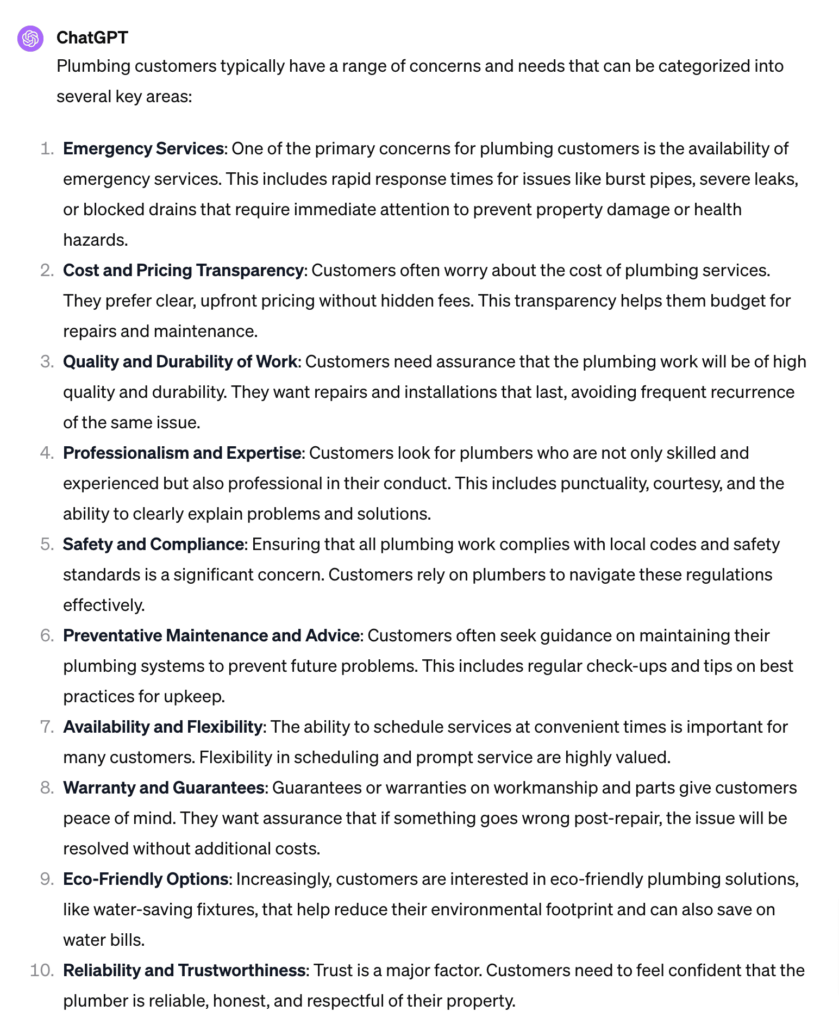
These results show you exactly what pain points your customers have and what you’ll need to address on the local landing page. If you’re addressing all the problems and worries of them, you’ll convert them like crazy!
The next step is to do some keyword research.
Keyword research with Semrush
My favorite tool to perform keyword research for a local business is Semrush. But you can use any other tool like Ahrefs, KeywordsEverywhere or mangools. In this article I’m going to be using Semrush’s keyword research tool.
- Access SEMrush
Go to the SEMrush website and log in to your account.
- Use the Keyword Overview Tool
Find the ‘Keyword Overview’ tool on the SEMrush dashboard. Enter a keyword you’re that promises you the highest ROI. This is usually a word or phrase related to your main service or product.
- Analyze Keyword Data
Review the data provided by SEMrush for your entered keyword. Look at key metrics like search volume (how many people search for this keyword), keyword difficulty (how hard it is to rank for this keyword), and CPC (cost per click for ads).
- Explore Keyword Variations
Use the ‘Keyword Magic Tool’ in SEMrush. Enter your initial keyword to find related keywords, synonyms, or variations.
- Examine Competitor Keywords
Use the ‘Competitive Research’ feature. Enter a competitor’s website to see what keywords they are ranking for. This can give insights into potentially valuable keywords you might have missed.
- Create a Keyword List
Select keywords based on how Google sees them. Be sure to create the page about ONE main keyword and its synonyms and very close variants. Those are keywords and phrases that satisfy the same search intent.
If your main keyword is “plumber” be sure to include “plumbing company” and “plumbing service” as these satisfy the same search intent. Sometimes it’s not as obvious as these suggest though.
Save these keywords in a list within SEMrush for easy reference.
Check out the key elements of a converting local business landing page that ranks:
Key Aspects of Effective Local Landing Pages
You can use the following key elements of a local page to rank and convert visitors into paying local customers. Each of the features should play a crucial role in improving the performance of your local business website.
9 Key Sections of a Local City Landing Page
In order to convert and rank a local business web page you’ll need to think about the key elements that enable your site to rank and convert.
1. Above the fold area
This is the most important part of any web page. It’s the one that a visitor sees when they arrive on the page. It’s supposed to make it crystal clear what the page is about, elements that convert like a USP and a call to action. A call to action is necessary to tell the user what to do. If you don’t tell them what the next step is, they may leave the page again.
2. Social Proof
Nothing converts better than opinions from other people. That can be testimonials, reviews, video testimonials, user stories etc.
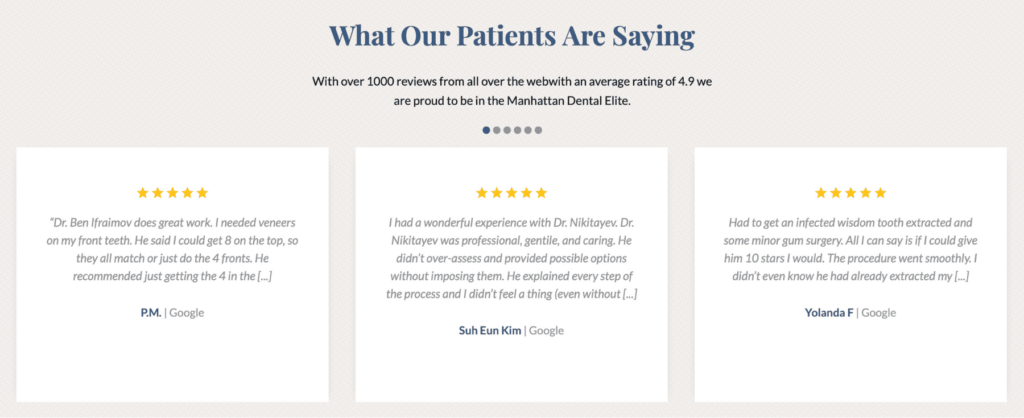
Be sure to add social proof across the page like these video testimonials:
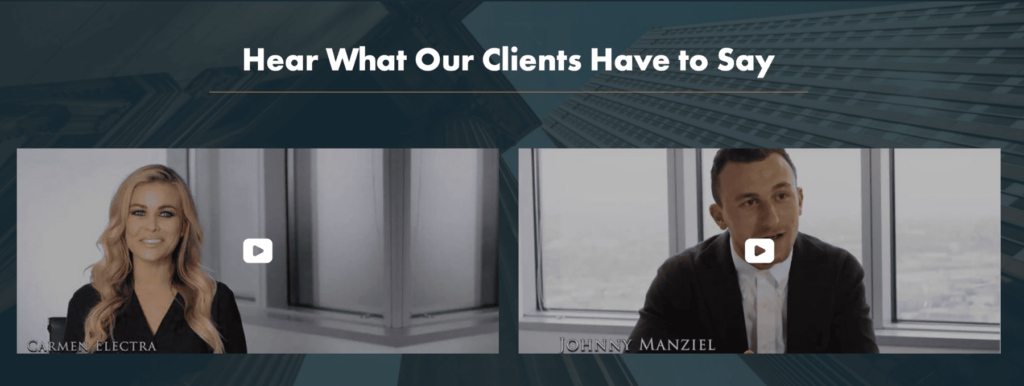
3. Unique Selling Proposition (USP)
This section is supposed to explain what people get from you and no one else. Keep in mind that you compete with other local businesses in your area and not globally. Do some research what other companies offer and figure out a way to make a compelling offer. Those elements can usually be found within a “Why choose us” section on a web page.
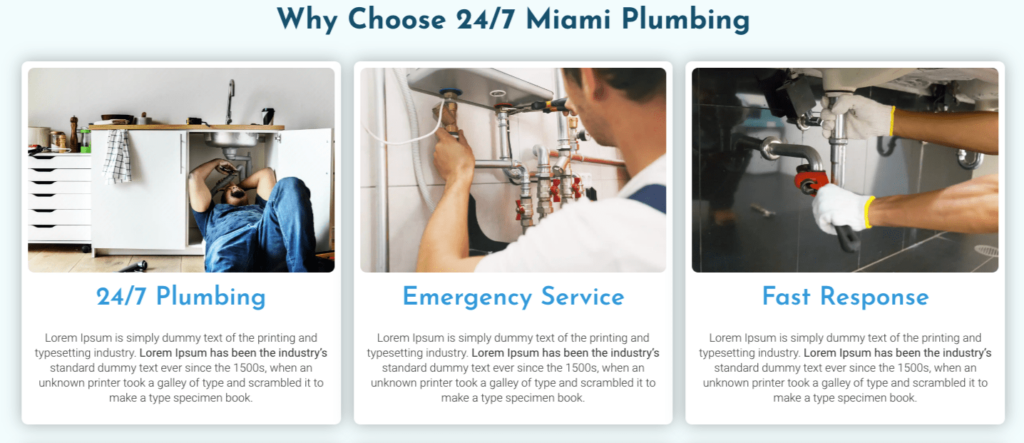
4. Visuals
Real images and videos are a great way to make people feel how it is to use your services or products. It gives them a first taste how the experience with you might be. Not all businesses can benefit from photos equally.
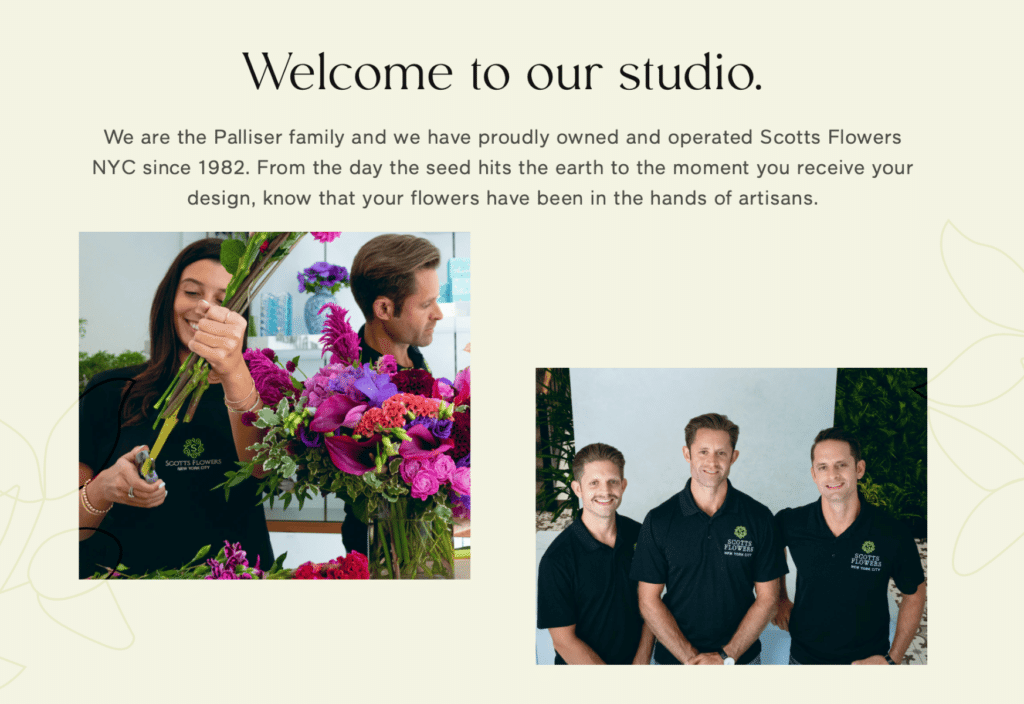
However, what usually works great for every vertical is staff and team images. Those can be taken from different angles and spread across the page or inserted in a gallery.
5. Services / Products
Cross-selling other products and services is a great way to show how else you can serve your customers. In case visitors have different needs, that’s a great way to convince them to do business with you.
6. NAP + Map
A local business should definitely list their name, address, and phone number on the page. An embedded map or a screenshot of a map can spice the experience up as well. Usually embedded map are performance killers. Try to figure out a way to embed a map so it doesn’t affect your user experience on the page. A service-area business website can leave out the address and add a service area map.

7. Certificates
It’s kind of another social proof element that is supposed to convince visitors. In some industries it’s a real conversion driver.
8. Localized content
Including local content is a great way to increase relevance to the local area. You can add parking information, mention railway or bus stations, and include manual driving directions that explain how to get to your location.
For service area businesses that can be mentioning case studies in certain districts/towns you service. Optimizing a landing page for the local area will increase the relevance for that area and you’re going to expand your ranking area eventually.
9. Frequently Asked Questions
A frequently asked questions section can answer the most common questions. Check your email inbox for typical recurring questions and answer them as simple as possible at the end of the page.
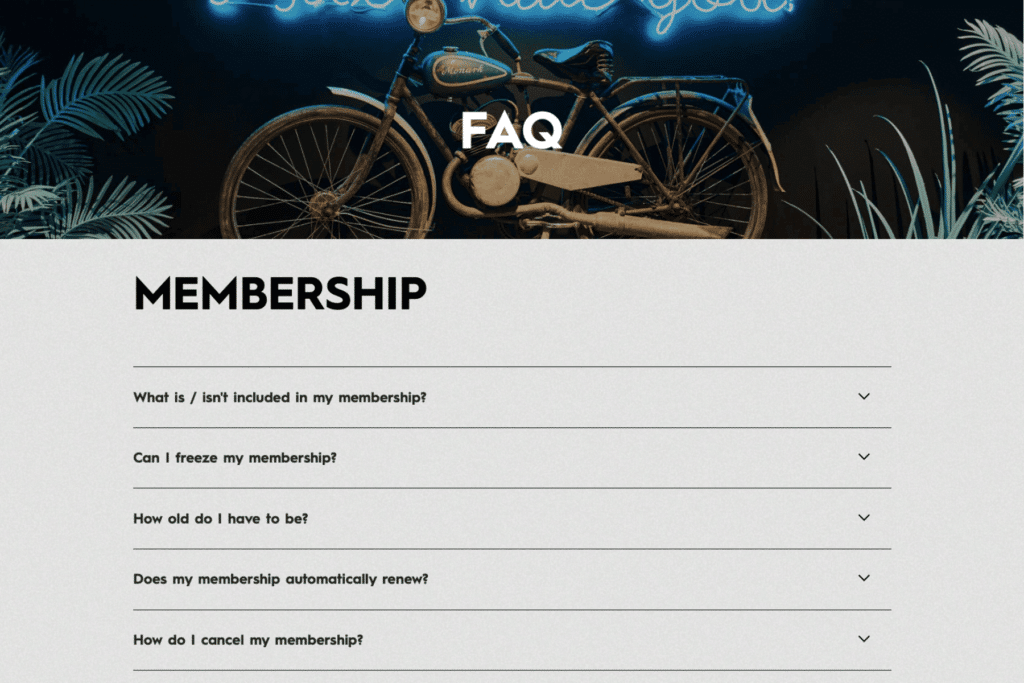
You can also provide answers to the issues found in the first research section of this article. It’s basically another way to display how you can help your customers. Plus, they can be shown in the people also asked section on Google and other search engines.
In order to convert and rank a local business web page you’ll need to think about the key elements that enable your site to rank and convert.
Key Elements of a Local Landing Page
URL
The URL structure depends a little on what type of landing page you create. Here are a few versions you can choose from:
Title Tag
The title tag needs to include your main service or product in the first place. Be sure to use the variant of your keyword that has the highest search volume. Relevance is key when it comes to search engine optimization. If you have some space left, add another phrase or keyword that would potentially increase your click-through rate (CTR). That can be a USP. Research has shown that including numbers in the title tag can increase CTR, too.

Meta description
The meta description is a pure conversion factor and has no effect on rankings. You should include your main keyword and potential factors like USPs that could improve the click-through rate.

Headings
The H1 headline is ideally part of the above the fold area. It should reflect what your title tag promised on the search results. People need to feel at the right place after clicking on a search result. If your title tag says “truck repair shop” you want to include “truck repair” in your H1 heading. Be sure to add keyword phrases, synonyms and variants to your sub headlines H2, H3. I would not recommend to go deeper than H3 on a landing page. Usually the topic doesn’t need much explanation and people are there to convert in the first place, not learn or get educated.
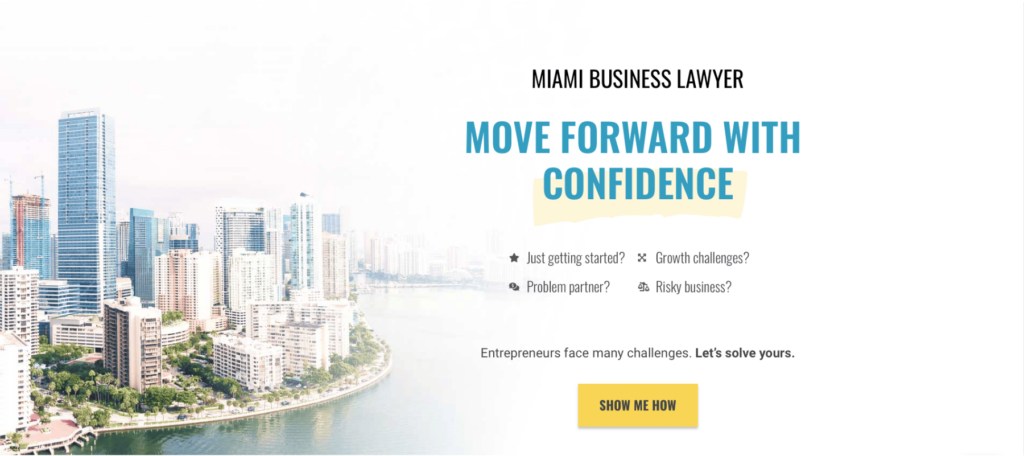
Introduction
The introducing first 100 words on a web page can make a huge difference in your conversion rate. Be sure to explain a little bit about the most important aspects of the page. It basically is an extension of the H1 headline and the slogan on your above the fold area. Be sure to include your main keyword and a call to action. Don’t bore people with typical phrases like “Welcome to our [service] page…”, which is typically an indicator for a low-quality landing page.
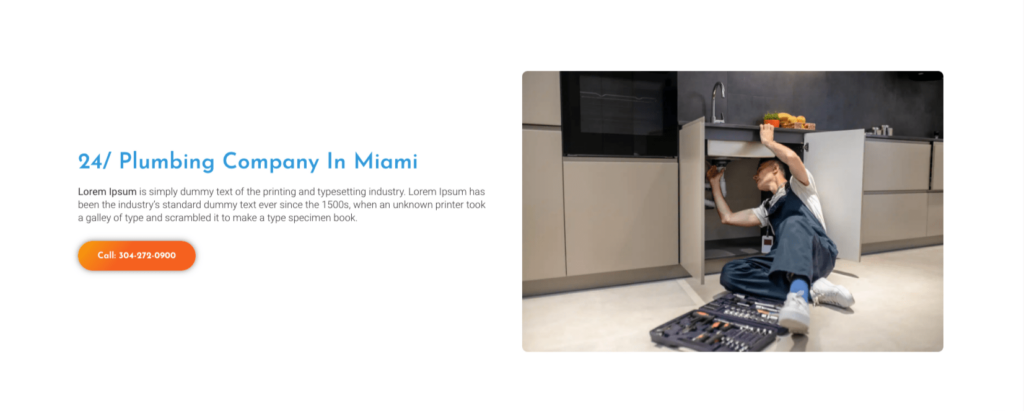
Body Content
The body content makes up for the majority of text. You want to include locally as well as topically relevant entities, keywords and phrases. However, walls of texts are conversion killers. So be sure to structuzre and design the content in a way the content is easy to consume and digest. People hate digging through hard to read text. It’s your job to educate them and keep them engaged on the page until they convert. Most local business websites are stuffed with keywords and text no one will ever read. Try to be different!
Image Optimization
The first images on your local laning page should contain keyword-relevant file names, alt texts and titles. Titles are shown as little notes when users hover over them with the mouse. They don’t hold much weight in terms of rankings.
File names do certainly hold some weight, they at least increase user experience and that’s what Google wants in the first place. In any way, be sure to use relevant images and then add relevant alt texts to them.
Links
You shouldn’t add many links to local landing pages. Most outgoing links should lead to other landing pages, not blog articles. Every link is a distraction and can possibly lead to a visitor leaving the site forever. Be sure to include links only if they’re necessary.
In terms of SEO, you definitely want to link to some other local landing pages that satisfy different search intents. Plus, you want to add links pointing to your landing page to relevant blog articles. That’s primarily to increase the authority of your landing page.
Local Business Schema
Schema markup or structured data is a way to explain to Google crystal clear what the page or element of a page is about. If you’re a local business or serving a local business client, you want to include local business Schema on the page so Google knows exactly what your website reflects. Most SEOs use RankMath which enables you to include local business Schema directly on your website. If you want to do it manually, please check out the Schema Markup generator.
<script type="application/ld+json">
{
"@context": "https://schema.org",
"@type": "AutoRepair",
"name": "Dragon Truck Repair Shop",
"image": "https://dragontruckrepairshop.com/featuredimage.pdf",
"@id": "dragontruckrepairshop.com",
"url": "dragontruckrepairshop.com",
"telephone": "304-272-0909",
"priceRange": "$$",
"address": {
"@type": "PostalAddress",
"streetAddress": "11 Ocean Ave",
"addressLocality": "New York City",
"addressRegion": "NY",
"postalCode": "10001",
"addressCountry": "US"
},
"geo": {
"@type": "GeoCoordinates",
"latitude": 40.6628385,
"longitude": -73.9626171
},
"openingHoursSpecification": {
"@type": "OpeningHoursSpecification",
"dayOfWeek": [
"Monday",
"Tuesday",
"Wednesday",
"Thursday",
"Friday"
],
"opens": "07:00",
"closes": "17:00"
}
}
</script>
Local Landing Page Example
As an inspiration, here is a local landing page example for a plumbing business. It’s very straightforward and if you want to use it as a template you need to adjust it for your specific needs. It’s supposed to show how a local city landing page should be structured.

Final Thoughts
This is how I create local landing pages that rank and convert. It’s important to use both search engine optimization (SEO) and attractive design & structure to engage your audience and encourage them to take action. Make sure to look at the example provided in this guide, as it will help you understand and use these ideas well.
With this knowledge, you can make local landing pages that not only attract visitors but also get them to take desired actions. Leave a comment below and share this article if you liked it.
Frequently asked questions
What is the difference between an ads landing page and one that is supposed to rank?
The main difference between a landing page for ads and one for local search engine ranking is this:
An ads landing page can be simple because it just needs to convert visitors into customers. In contrast, a local landing page made for search engines has a lot of content. This helps it show up in search engine results. It’s tougher to make because it needs to do two things: rank well in searches and convert visitors into customers.
How to appear in multiple city searches with one website?
To appear in multiple city searches with one website you can create location landing pages. Those pages are supposed to rank for “service in city”. Use this local landing page guide to create a landing page and optimize it for [service + city].



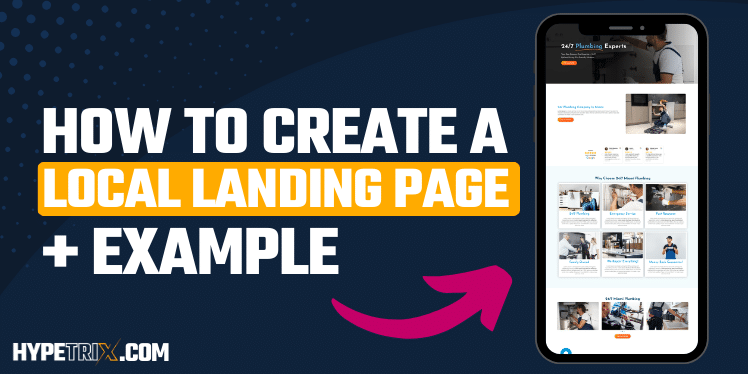
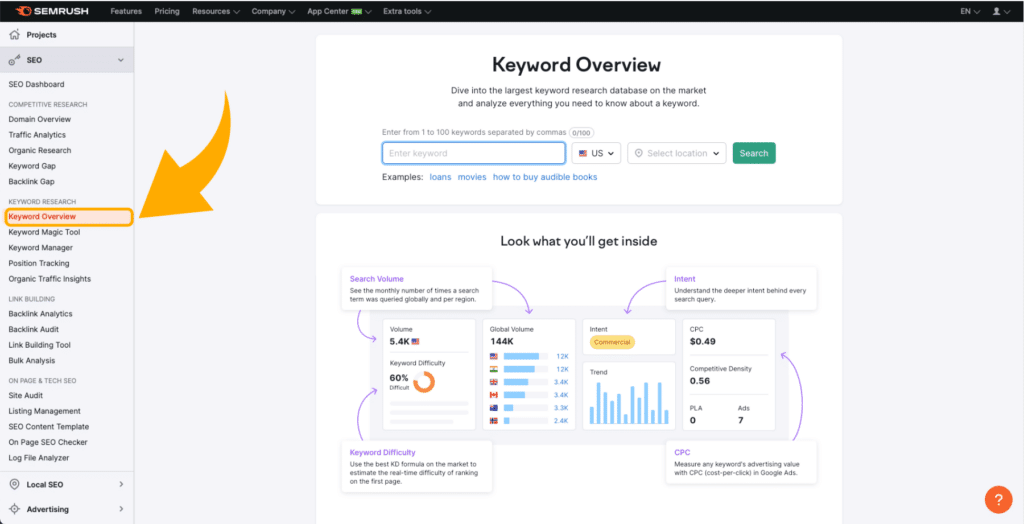
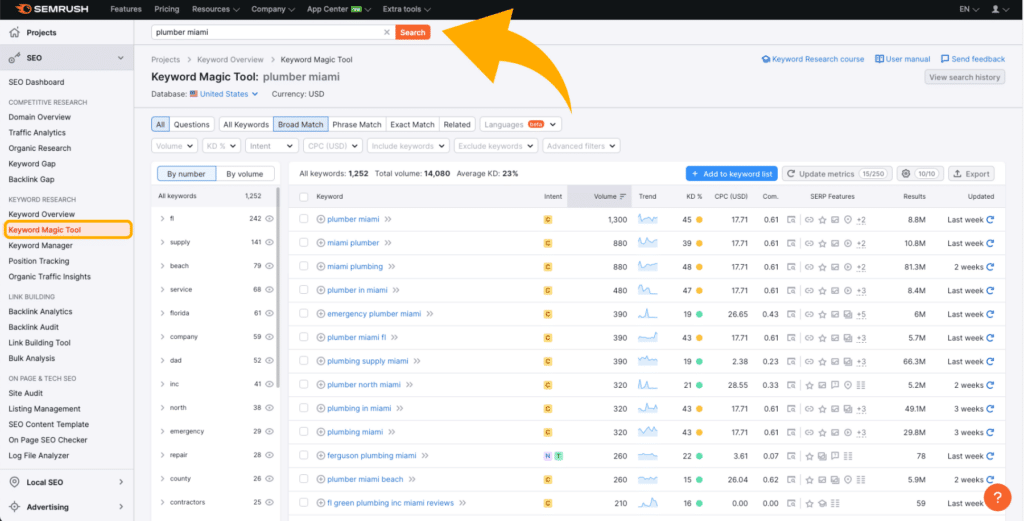
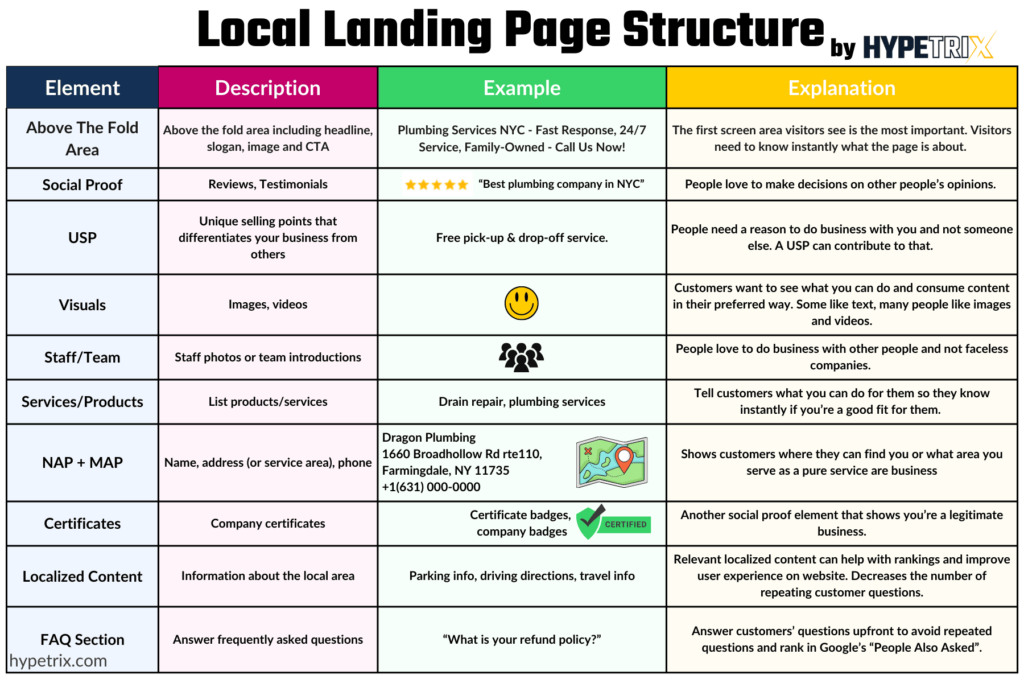
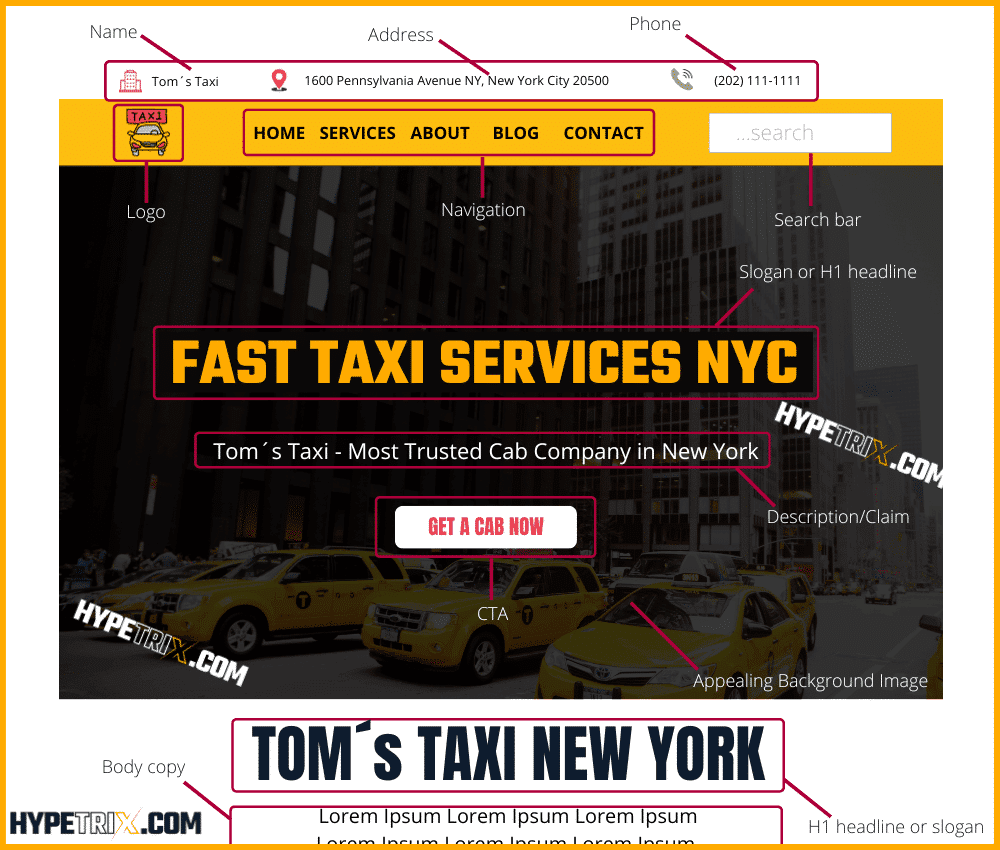
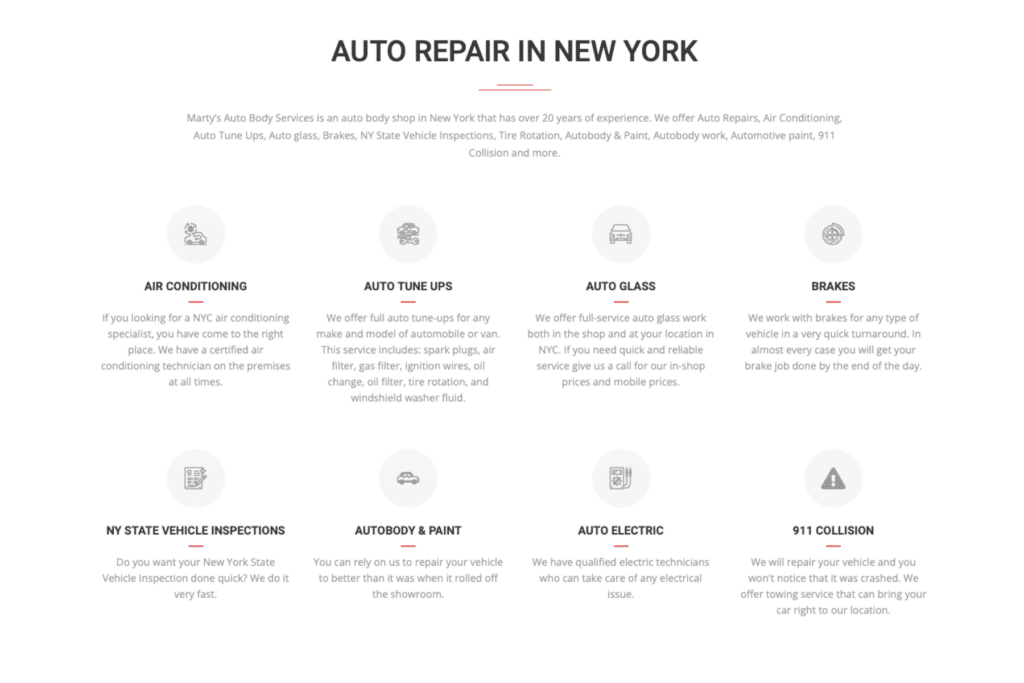


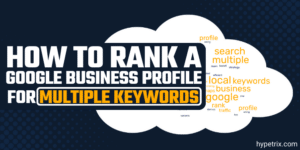
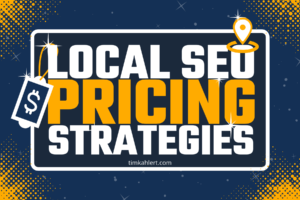
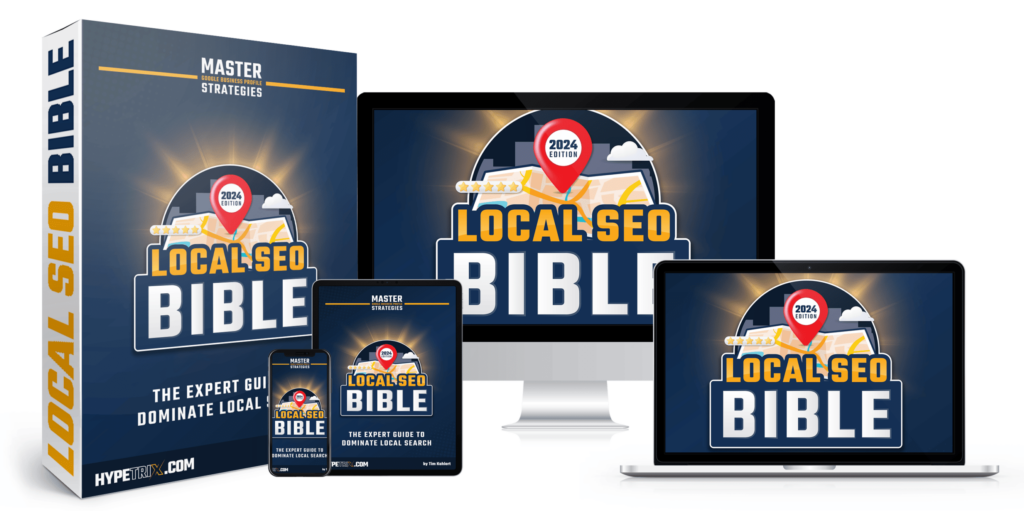
This is awesome
Thank you for the comment, Felipe! Glad you like it.
What a brilliant piece of cake with simple and easiest approach location pages…. Love it much more
Thanks a lot, Sami! Much appreciated!
Thank you Tim. It gonna be my guides when I build a landing page. But I want to ask a little thing. How to make our landing page good in search engine without article inside web? Can we do it?
In the image of “above fold section” there are two H1 Headings. Please correct them. thanks
Thank you, Sami! It’s an either-or situation. You can either have the slogan at the top and the headline down or have the heading at the top and the slogan somewhere else. That’s why it says “headline or slogan”.
Thanks for clarification!!
This is a fantastic and thorough guide for city page search engine optimization. You didn’t miss anything Tim!
Thank you, Filip!